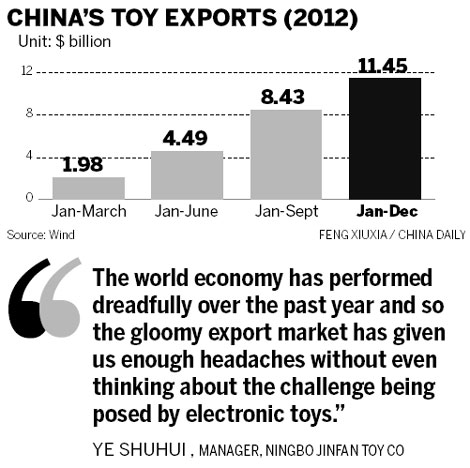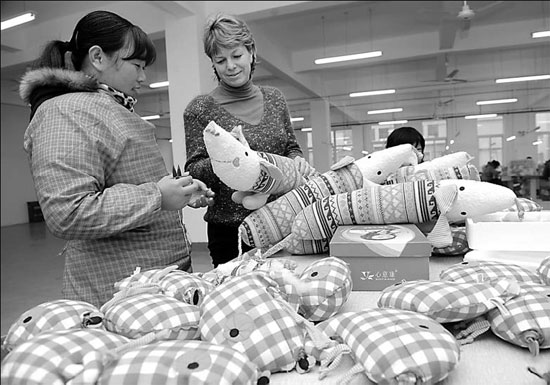Toy makers feel pinch of decrease in exports
Updated: 2013-01-28 05:45
By Shi Jing in Shanghai (China Daily)
|
||||||||
|
An overseas businesswoman examining cloth toys at Huainan Youtong Toy Co in East China's Anhui province. The Anhui toy maker exports its products to the European market. The per capita monthly income of its staff, most of whom are from the countryside, is nearly 2,000 yuan ($321). Chen Bin / For China Daily |
As world economy stutters, nation's businesses focus on domestic sales
Traditional toy makers in China say they are being hit hard on two fronts: a dramatic fall in exports and a huge rise in the popularity of electronic toys.
"Our sales revenue dropped 20 percent last year, largely due to the decline in export orders," said Ye Shuhui, manager of Ningbo Jinfan Toy Co, which sells most of its toys to the United States, Europe and Southeast Asia.
"The world economy has performed dreadfully over the past year and so the gloomy export market has given us enough headaches without even thinking about the challenge being posed by electronic toys."
Although the number of orders picked up in the latter half of 2012, said Ye, it still didn't help much.
Instead of calculating how much profit the company made last year, he added that this year he is still simply thinking about survival.
"Expensive toy making in China still belongs to a labor-intensive industry," he added, meaning that to make ends meet, the only solution has been to raise prices by about 30 percent.
According to estimates by Euromonitor, the market research firm, total retail sales of toys and games in China soared in value from $3.89 billion in 2007 to $8.3 billion in 2011, registering an average annual growth rate of 21 percent.
China's toy exports were worth $11.45 billion in 2012, a slgiht rise of 5.8 percent year-on-year, according to the Shanghai-headquartered Wind Information Co.
For most export-oriented toy makers in Yangzhou, in East China's Jiangsu province, the story is the same, despite its reputation as being the country's best known toy manufacturing area.
"Overseas orders were down by at least 40 percent in 2012 and that's had a huge impact on Chinese toy exports," said Yang Junliang, the sales manager of Yangzhou Oasis Ocean Toys.
"Although labor costs have remained steady over the past year, workers' salaries at around 3,000 yuan ($482) a month are still considered high by factory owners.
"Polyester, the raw material we use the most, has also seen its price rise by about 10 percent since June last year," added Yang, who used to export his toys to United States and most of Europe.
According to export analysts, the world's economy remained stagnant last year.
The US still lacks strength, the European Union remains on the verge of economic recession and economic growth has generally slowed in all developing countries, the key markets for China's top exporters.
Oasis Ocean Toys has now started selling its previously export-targeted products in the Chinese market, Yang said, so the company at least managed to see some growth last year, although not by a significant amount.
This trend of exploring the Chinese market has also started to have a strong influence in Dongguan, a city once known as the "world's factory" in Guangdong province which has always been seen as a key top manufacturing city, according to David Zhang, a research analyst specializing in the toy market with Euromonitor.
"The lousy performance of the overseas market has at least helped to boost the Chinese market by introducing more competition," said Zhang.
"Toy manufacturing has become quite scattered, but the difficulties in the overseas market have meant that stronger companies have been able to consolidate their position, while weaker, less competitive ones have quit," he added.
The leading players in the Chinese market also represent some of the biggest names in the global market.
In October, Guangdong Alpha Animation and Culture Co signed an investment agreement with US entertainment giant Hasbro Inc to establish a joint venture for the development and design of animation toys.
The JV will attract a total of $15 million from both sides and will distribute products and manage the use of brands globally.
The Nasdaq-listed Hasbro is a branded play company providing a wide-range of entertainment offerings based on the company's global brand leaders such as Transformers, My Little Pony, and Monopoly, among others.
Although generally welcomed, the Hasbro deal has signaled the other the big challenge facing Chinese toy makers - that world-renowned companies are keen to get their own slice of the China market.
Hong Kong Trade Development Council reported in its China's Toy Market Report released in August last year that it is estimated about 75 percent of toys worldwide are made in China.
It highlighted the main toy production and export bases are the "five provinces and one city": Guangdong, Jiangsu, Shandong, Zhejiang and Fujian provinces and Shanghai municipality.
The bulk of toy exports are produced to original equipment manufacture orders for foreign brands.
However, the report concluded that foreign products and products made by Sino-foreign joint ventures make up the lion's share of the Chinese toy market and the majority of the locally-made toys remain at the medium- to low-end of the market.
Their product range is limited, with plush toys and wooden toys being the mainstay. In terms of pricing, there is also a huge gap between Chinese made toys and foreign brands.
As such, Chinese toys still maintain a strong edge in the medium- to low-end segments of the market and practically monopolize sales channels in the wholesale market and among individually-run retailers.
Zhejiang Muwan Toys Co, a 40-year-old company, which specializes in the production of wooden toys, started looking at its e-commerce functions as early as 2007.
"Apart from the department store Bao Da Xiang Shopping For Kids, which is famous in Shanghai, we have been using e-commerce a lot and are one of the first toy makers in China to start B2C services," said Yu Jiangnan, its regional marketing manager.
Although the company does no export business, it expected to achieve 30 percent growth in 2012.
"We are also producing toys to our own design, which is another comfort to customers, especially at a time of economic uncertainty," he said.
Like so many area of modern life, electronic devices such as the iPad are having an effect on the Chinese toy industry.
According to industry experts, many parents consider them to be a companion for their children and, as such, should not be seen as a threat to them using or enjoying toys.
The current Chinese toy market is differentiated according to age groups, with toddlers and babies under the age of 5 being the major buyers of traditional toys and those above 5, able to use iPads and other electronic devices to play on, according to Euromonitor.
Much the bigger threat to the industy, it says, is from those companies ignoring intellectual property rights, designing or selling products illegally.
According to Euromonitor, only 60 percent of toy makers in China are considered "authorized".
"Without an awareness of the intellectual property rights, there cannot be sound competition in the market.
"It would also be difficult for Chinese toy makers to establish their own brand names," said Zhang of Euromonitor.
shijing@chinadaily.com.cn

(China Daily 01/28/2013 page17)

 In Photos: 7.0-magnitude quake hits Sichuan
In Photos: 7.0-magnitude quake hits Sichuan
 Li Na on Time cover, makes influential 100 list
Li Na on Time cover, makes influential 100 list
 FBI releases photos of 2 Boston bombings suspects
FBI releases photos of 2 Boston bombings suspects
 World's wackiest hairstyles
World's wackiest hairstyles
 Sandstorms strike Northwest China
Sandstorms strike Northwest China
 Never-seen photos of Madonna on display
Never-seen photos of Madonna on display
 H7N9 outbreak linked to waterfowl migration
H7N9 outbreak linked to waterfowl migration
 Dozens feared dead in Texas plant blast
Dozens feared dead in Texas plant blast
Most Viewed
Editor's Picks

|

|

|

|

|

|
Today's Top News
Live report: 7.0-magnitude quake hits Sichuan, heavy casualties feared
Boston suspect cornered on boat
Cross-talk artist helps to spread the word
'Green' awareness levels drop in Beijing
Palace Museum spruces up
First couple on Time's list of most influential
H7N9 flu transmission studied
Trading channels 'need to broaden'
US Weekly

|

|








